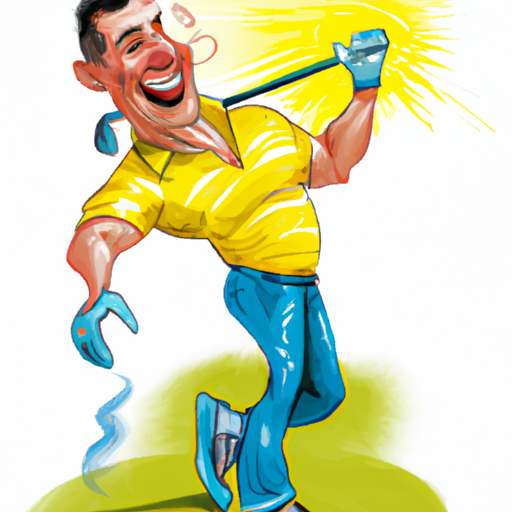- Home
- Golf Swing
- Flat Golf Swing
Flat Golf Swing: The Lazy Golfer's Guide for Weekend Triumphs
Are you an inconsistent golfer struggling with your swing? Do you dream of hitting long, straight shots that leave your buddies in awe? Well, your solution might be simpler than you think: the flat golf swing.
This guide is designed to help you understand and master this technique, transforming your game and making your golfing weekends a triumph.
But how does it work, and why is it so effective?
Let's dive in and find out.
The Lazy Golfer's Guide: Mastering the Flat Golf Swing for Weekend Triumphs
Hello, fellow golf enthusiasts!
I'm a weekend golfer, just like you.
I've had my fair share of embarrassing moments on the first tee, and I've spent countless hours (and dollars) trying to improve my game. I've been there, struggling with inconsistent swings, feeling the sting of defeat against younger, stronger, and better-equipped golfers.
But guess what?
I found a way to turn the tables.
Today, I'm here to share my journey and the secret that transformed my game: the flat golf swing.
So, are you ready to get started?
What is a Flat Golf Swing?
What is a flat golf swing you might ask. A flat golf swing is one that is more horizontal, or "under" the plane, in relation to a standard swing plane.
The swing plane is the path your club takes during your swing. A flat swing is typically caused by your hands working around your body, resulting in the clubhead finishing behind your lead shoulder.
It's a technique that can drastically change your game, but like everything in golf, it has its pros and cons.
Pros and Cons of a Flat Golf Swing
So, what are the pros and cons of a flat swing?
Well, a flat golf swing can lead to more consistent ball striking and better control, especially for golfers with shorter arms or less flexibility. However, it can also lead to issues like slices and pulls if not executed correctly.
But don't worry, with the right understanding and practice, these can be managed effectively.
How to Identify if Your Golf Swing is Too Flat
Now, you might be wondering, how do I know if my golf swing is too flat?
A swing is considered too flat when the left arm forms an angle of less than 45° with the ground at the top of the backswing. If your shots are consistently going right (for right-handed golfers), or if you're struggling with slices, these could be signs that your swing is too flat.
How to Correct a Flat Golf Swing
So, how do I stop swinging flat golf you ask?
The key is to work on your swing plane. Drills that promote a more upright swing can help, as can focusing on keeping your left arm (for right-handed golfers) more vertical during the backswing.
Remember, it's all about finding the right balance that works for your unique swing.
Drills for a Flat Golf Swing
There are several drills you can practice to improve your flat golf swing. These include the "Frisbee Throw Drill" to improve your swing plane, the "Towel Drill" to enhance your arm positioning, and the "Basketball Drill" to better your rotation and weight transfer.
Practice makes perfect, so don't shy away from spending time on these drills.
Flat vs. Upright Backswing in Golf
Finally, let's address the question: what's the difference between a flat and upright backswing?
A flat backswing is more horizontal and tends to go around the body, while an upright backswing is more vertical and goes more up and down. Both have their advantages and can be effective depending on the golfer's physique, flexibility, and personal comfort.
Key Takeaways
Mastering the flat golf swing can be a game-changer for many golfers, especially those who are shorter or less flexible. While it can have its challenges, with understanding and practice, it can lead to more consistent and controlled shots.
Remember, golf is a game of patience and continuous learning. So, keep practicing, keep improving, and most importantly, keep enjoying the game.
And we don't stop there...
The Golfeaser Manifesto: A Weekend Golfer's Journey
As a weekend golfer, I've lived by the Golfeaser Manifesto.
I've found my own way to improve my game, hit long drives down the fairway, impress my buddies, earn the right to brag, and change the world one round at a time. I've discovered the dirty little secrets that shaved strokes off my score, and I've found the quick fix that added yards to my tee shot.
I've been where you are, feeling the frustration of inconsistent swings and the humiliation of poor performances.
But I've also felt the exhilaration of hitting a golf ball so far it disappears in the distance, yet so accurately it resembles a guided missile. I've felt the pride of stunning my buddies with my improved skill, and the satisfaction of knowing that I've earned my bragging rights.
I've learned that golf is not just about the score, but about the journey. It's about the thrill of the hunt, the joy of being outdoors, and the camaraderie of playing with friends. It's about the challenge of improving, the satisfaction of success, and the lessons learned from failure.
So, if you're an inconsistent golfer looking for a way to improve, I encourage you to embrace the flat golf swing. Practice the drills, understand the pros and cons, and find the balance that works for you.
And remember, golf is a game of patience and continuous learning. So, keep practicing, keep improving, and most importantly, keep enjoying the game.
Conclusion
Mastering the flat golf swing can be a game-changer for many golfers, especially those who are shorter or less flexible. While it can have its challenges, with understanding and practice, it can lead to more consistent and controlled shots.
- So, are you ready to take your golf game to the next level?
- Are you ready to impress your buddies with long, straight drives down the fairway?
- Are you ready to live by the Golfeaser Manifesto and change the world one round at a time?
If so, then it's time to embrace the flat golf swing and start your journey towards becoming a better golfer.
You're reading what I'm saying, right? You know what this means, right?
It's time to get out there and start practicing. After all, the only thing standing between you and your golfing goals is a little bit of knowledge and a lot of practice.
So, what are you waiting for? Get out there and start swinging!
Frequently Asked Questions about Flat Golf Swing
What is a flat golf swing?
What is a flat golf swing?
A flat golf swing is a type of swing where the club moves more horizontally or "under" the plane compared to a standard swing. It's often the result of your hands working around your body, causing the clubhead to finish behind your lead shoulder.
What are the pros and cons of a flat swing?
What are the pros and cons of a flat swing?
A flat golf swing can lead to more consistent ball striking and better control, particularly for golfers with shorter arms or less flexibility. On the flip side, it can also lead to issues like slices and pulls if not executed correctly.
How do I know if my golf swing is too flat?
How do I know if my golf swing is too flat?
Your swing might be too flat if your left arm forms an angle of less than 45° with the ground at the top of the backswing. Consistently hitting shots to the right (for right-handed golfers) or struggling with slices could be signs of a too flat swing.
How do I stop swinging flat golf?
How do I stop swinging flat golf?
Correcting a flat golf swing involves working on your swing plane. Drills that promote a more upright swing can help, as can focusing on keeping your left arm (for right-handed golfers) more vertical during the backswing.
What's the difference between a flat and upright backswing?
What's the difference between a flat and upright backswing?
A flat backswing is more horizontal and tends to go around the body, while an upright backswing is more vertical and goes more up and down. Both have their advantages and can be effective depending on the golfer's physique, flexibility, and personal comfort.
What are some drills for a flat golf swing?
What are some drills for a flat golf swing?
There are several drills you can practice to improve your flat golf swing. These include the "Frisbee Throw Drill" to improve your swing plane, the "Towel Drill" to enhance your arm positioning, and the "Basketball Drill" to better your rotation and weight transfer.
How can a flat golf swing help me improve my game?
How can a flat golf swing help me improve my game?
A flat golf swing can lead to more consistent and controlled shots. With understanding and practice, it can help you lower your score, hit longer drives, and impress your buddies on the golf course.
What is the Golfeaser Manifesto?
What is the Golfeaser Manifesto?
The Golfeaser Manifesto is a guiding principle for weekend golfers. It encourages golfers to improve their own game, hit long drives down the fairway, impress their buddies, earn the right to brag, and change the world one round at a time. It's about finding the dirty little secrets that will shave strokes off your score and finding the quick fix that will add yards to your tee shot.
















